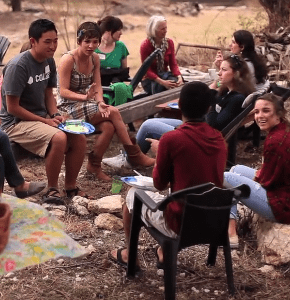Campus Missional Communities
Every missional community looks different because they’re each reaching out to a different target audience. This missional community shaped their activities and strategies to reach out to international students, but a group reaching out to athletes would have to do things differently.
Missional Community-International Students from The Austin Stone on Vimeo.
You can use the principles of this video to form your own missional communities on campus if the following elements are included:
Vision
Acts 17:26 “26 And he made from one man every nation of mankind to live on all the face of the earth, having determined allotted periods and the boundaries of their dwelling place,27 that they should seek God, and perhaps feel their way toward him and find him. Yet he is actually not far from each one of us …”
Using the people of the church to bridge the gap between the world and the church.
“It’s a community effort to bring our world into theirs, for the sake of the Gospel” – Paul Lee
“We want to be the church all week long” – Lawson Flowers
Mission
Pick one specific population to invest your life in and focus on it specifically. This population should be within your reach and have needs that you can minister to.
The goal is to share your life with a target population not just share the Gospel. If they reject the message it is not time to leave them behind but to continue to love and invest in them.
“One of the girls actually told me that, she knew that I was a missionary, she knew that as a Christian missionary I would have motives, but what she told me was, she never thought that that was the pinnacle of our friendship, she actually thought that I was her friend and that I valued her as a person and not her as some project I needed to convert and tell her all my beliefs.” – Paul Lee
Elements of Strategy
3rd Place Locations: A neutral place where you don’t use religious language and where Christians and lost friends can meet together. The target population should naturally want to be there and feel free to enter and leave as they please. Conversations should flow naturally but are intentional and meaningful.
Prayer Meeting Times: Time spent praying that the Holy Spirit would move within the heart of the target population.
Bible Study Times: A once a week time to gather, eat a meal, spend some time reading the Word, sharing highs and lows, confessing sins, praying for one another, and to regroup before facing another week of living on mission.
Monthly Events: Big events that are desirable for the target population to attend so that new relationships may be formed and existing relationships can grow.
Discipleship Meeting Times: Regular one-on-one meetings between missional community members and the new believers that found the Lord as a result of the group (or otherwise).
If you’re not yet convinced that all the different elements of missional communities are really necessary, then listen to the story of Luke and how he came to know the Lord through a similar group.
Missional Communities have the potential to make a huge impact in fulfilling the Great Commission. However, it is very easy for groups to fall into old habits or misunderstand the true mission and vision of their groups. To resist that tendency, consider viewing and showing this video series from Austin Stone about What a Missional Communities is NOT:
not a support group
not a social activist group
not a Bible study
not a weekly meeting
not a small group
Using These Videos in Your Ministry
These videos can be used in any number of ways to help cast vision for missional communities in your ministry. You could show them to your entire ministry at once, in small group meetings, in leadership meetings, or in one-on-one discipleship meetings. But in any case each video should be used strategically as a part of an overall plan for implementing missional communities on your campus. Think of them like you would discipleship resources. When you see a need for your students to see missional communities in action, show them the UT video. When you see them discouraged by a lack of fruit, show them the Luke video. When you see them falling back into old habits, show them one or all of the videos about what Missional Communities are not. Or show them all at once to begin a campaign for starting missional communities in the next semester.
Starting and encouraging the formation of missional communities from your students can take as much care and attention as actually leading one. You should to be just as invested in their journeys as you’d like them to be in the ones they are reaching out to.
Questions for Discussion
After watching these videos yourself, what do you admire about them?
What do you find yourself still skeptical of?
How do these videos and review clarify your understanding of missional communities?
What would it look like to start missional communities on your campus?
Are there some action steps for implementing this strategy that you’d like to take now?


